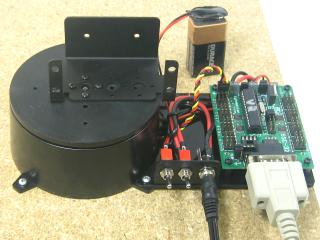Arm Base Assembly Guide v2.1
| Arm
Base Assembly Guide v2.1.
Updated December 2014 Note
that this guide shows how to assemble the arm base with either
the SSC-32 or the SSC-32U servo controller. Take note of which you have
and follow each step accordingly, as the connections and configuration are different. Safety first! Wear eye
protection and never touch a powered robot! |
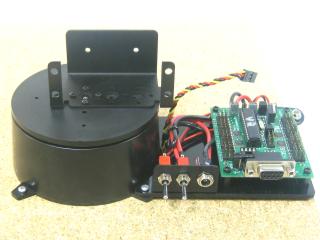 Arm Base mounted (SSC-32 shown) |
||||||||
| Step
1. Insert the stainless steel pins into the plastic bearings as shown.
|
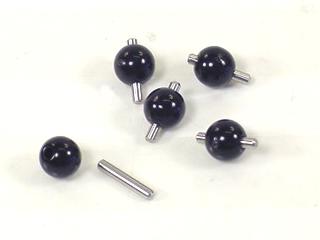 Figure 1. |
||||||||
| Step
2. Install the bearings into the base as shown. They will fit snugly. Note, the notch in the bottom edge of the base indicates the back. |
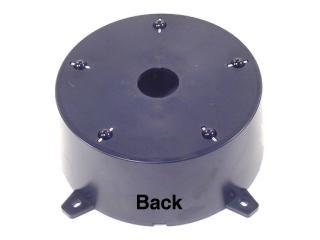 Figure 2. |
||||||||
| Step
3. Lay a piece of 400 grit sandpaper on a flat surface and move the base (upside down) in small circles on it. This will remove any imperfections on the bearings. |
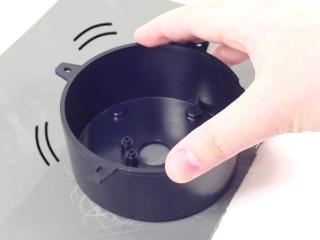 Figure 3. |
||||||||
| Step
4. Figure 4 shows the circle pattern on the sandpaper and the inset shows the bearings after any imperfections have been removed. |
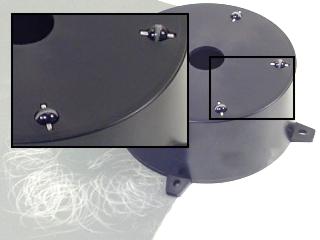 Figure 4. |
||||||||
| Step
5. Figure 5 illustrates a typical standard-size servo with its output horn (the round white part) at center position. Make sure your servo looks like the image, and then carefully remove the servo horn screw and pull the horn straight off of the servo.
|
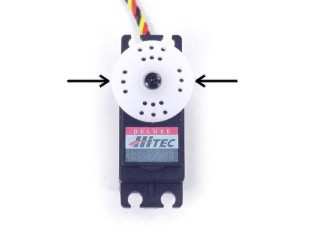 Figure 5. |
||||||||
| Step
6. Place the servo in the base as shown and screw it in tightly using four #4 tapping screws.
|
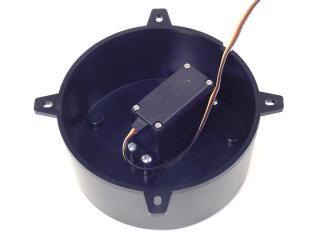 Figure 6. |
||||||||
| Step
7a. If you are not building an AL5D arm, attach the ASB-201 bracket onto the base top, using four 2-56 x .250" phillips head machine screws and four 2-56 nuts as shown. Note, the bracket and hardware are included in the arm kit, not the base kit. DO NOT USE LOCTITE ON PLASTIC
|
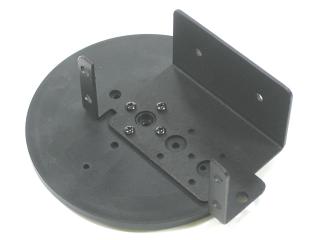 Figure 7a. |
||||||||
| Step 7b. If you are building an AL5D robotic arm, attach an ASB-204 bracket onto the base top, using four 2-56 x .250" phillips head machine screws and four 2-56 nuts as shown. Note, the bracket and hardware are included in the arm kit, not the base kit. DO NOT USE LOCTITE ON PLASTIC
|
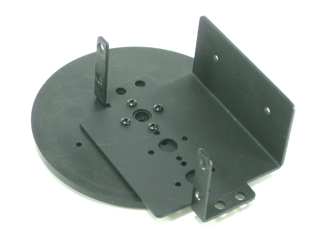 Figure 7b. |
||||||||
| Step
8. Add a drop of silicone-based oil to each bearing. |
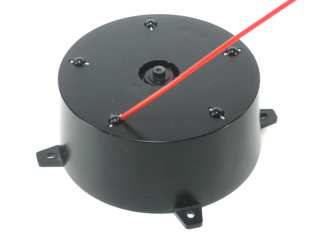 Figure 8. |
||||||||
| Step
9. Install the base top. The hole pattern should line up as shown in Figure 9, with one line pointing to the servo wire hole, and all of the lines pointing between the mounting tabs. Note, this top piece is manufactured to be a tight fit. You might have to press very hard. Attach the top with the servo horn screw. |
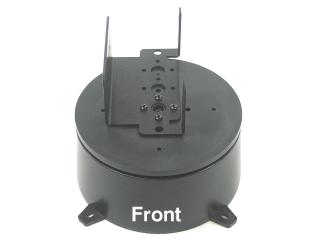 Figure 9. |
||||||||
| Step
10. Route the base servo's cable through the hole in the back of the base. This will keep the base level to the mounting surface. |
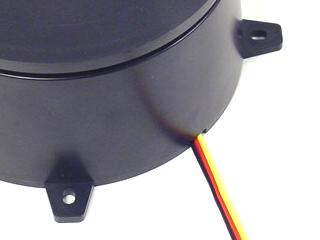 Figure 10. |
||||||||
| Step
11. Attach the 3/8" hex spacers as shown, using four 1/4" hex socket screws.
|
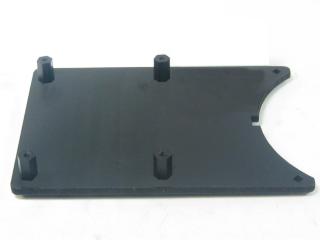 Figure 11. |
||||||||
| Step
12. Install the power switch bracket using two 3/8" hex socket screws and two nylon insert lock nuts.
|
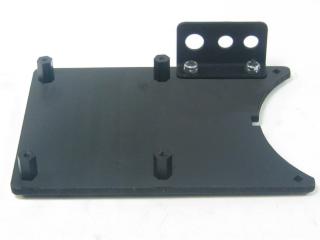 Figure 12. |
||||||||
| Step
13. Install the power plug wiring harness as shown. Use a tie wrap to hold the wires in place as shown. The pre-wired harness and wall pack must be checked before they are connected to the SSC-32. Put the black lead from a voltmeter on the black wire, and the red lead on the red wire. Plug the wall pack into the wall and insert the other end into the matching connector. Turn the voltmeter on and set it to measure DC volts. Turn on the power switch on the wiring harness. The voltmeter should read around +6vdc. If it reads -6vdc then DO NOT connect it to the SSC-32 and contact us. Yes, we found one of the wiring harnesses assembled backwards. |
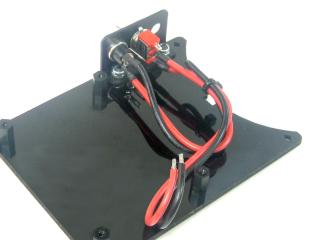 Figure 13. |
||||||||
| Step
14a (SSC-32) The SSC-32 may require the use of a 9V power source to power the logic. As such, install the 9vdc battery wiring harness as shown. Note that this is needed only for the older SSC-32 (serial port), and not the SSC-32U (USB port). The SSC-32U does not include this cable as it is not needed. |
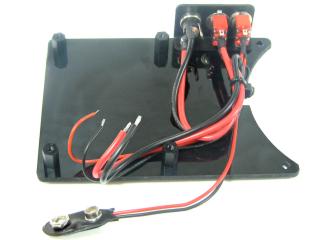 Figure 14a (Setup for SSC-32). |
||||||||
| Step
14b (SSC-32U) The SSC-32U does not need a separate power source for the logic, and as such, the arm kits do not include a separate 9V wiring harness, and you can continue to the next step. |
 Figure 14b (Setup for SSC-32U). |
||||||||
| Step
15. Install the SSC-32 (shown) or the SSC-32U using four 1/4" hex socket screws. Do not make the electrical connections yet.
|
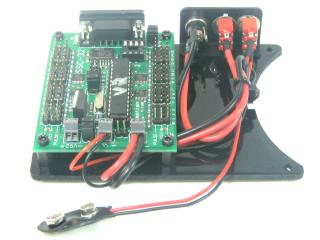 Figure 15 (SSC-32) |
||||||||
|
Step 16a (SSC-32). A brownout can occur when a single power supply is used for servos and logic. If they are sharing a single supply it is possible for the servos to draw too much current, causing the microcontroller to reset. The easiest way to insert the
wires is to use wire cutters to remove some of the shielding at the end
(~0.5cm) and then trim the end of the multi-strand wire, ensuring all
of the wires are straight and compact. Ensure no wires touch between the red and black leads at the screw terminals! |
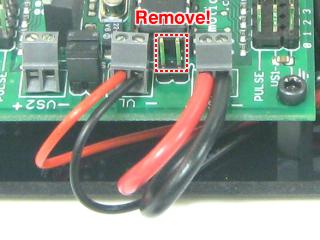 Figure 16a (SSC-32) |
||||||||
| Step 16b (SSC-32U). Unscrew the VS1+ and VS1- terminals so the wires can pass through. Insert the wires to the VS1 input as shown, making sure the black wires goes to (-) and the red wires goes to (+). Tighten the screws to ensure the wires are secure, and verify that there are no loose strands which may cause a short circuit. Leave the VS1 = VS2 jumpers in place. There should be no jumper on VS = VL. The screw terminal is fully open when the base of the metal opening is at the bottom of the plastic. The screw is rotate to compress the wires from the bottom up. The easiest way to insert the wires is
to use wire cutters to remove some of the shielding at the end (~0.5cm)
and then trim the end of the multi-strand wire, ensuring all of the
wires are straight and compact. Ensure no wires touch between the red and black leads at the screw terminals! |
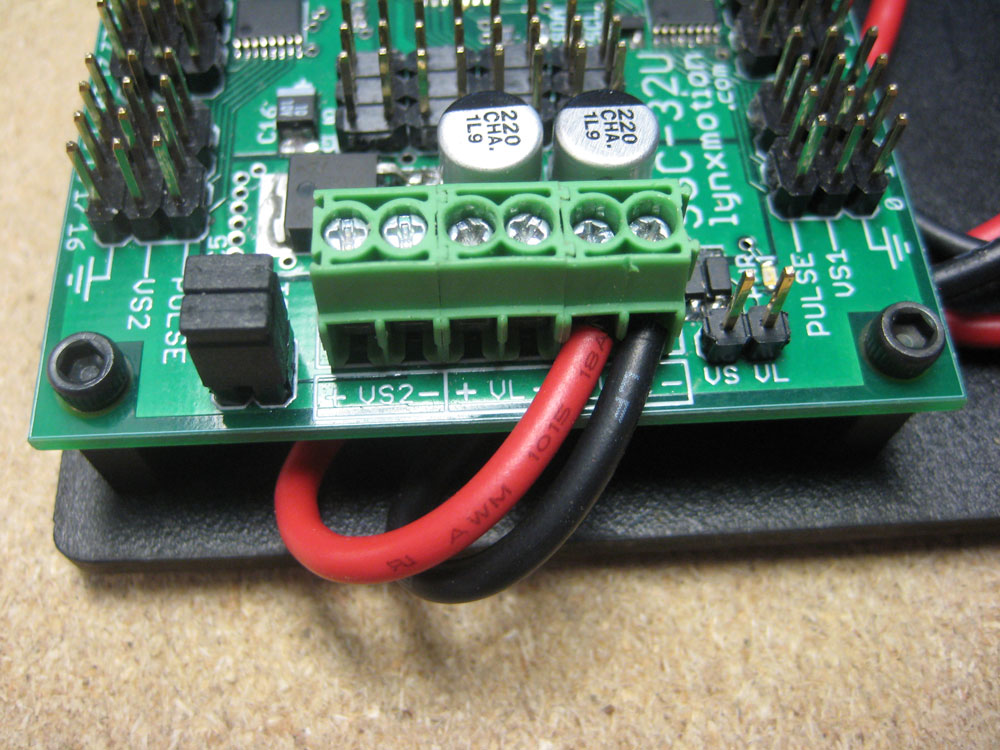 Figure 16b (SSC-32U) |
||||||||
| Step
17a (SSC-32). Mount everything to a piece of plywood (or similar surface). Attach the electronics carrier as shown. Make sure to route the base rotate servo wire through the holes, and verify that it isn't being pinched. Use the #4 x .500" tapping screws to secure the assembly to the plywood.
|
 Figure 17a (SSC-32) |
||||||||
| Step
17b (SSC-32U). Mount everything to a piece of plywood or the like. Attach the electronics carrier as shown. Make sure to route the base rotate servo wire through the holes, and verify that it isn't being pinched. Use the #4 x .500" tapping screws to secure the assembly to the plywood.
|
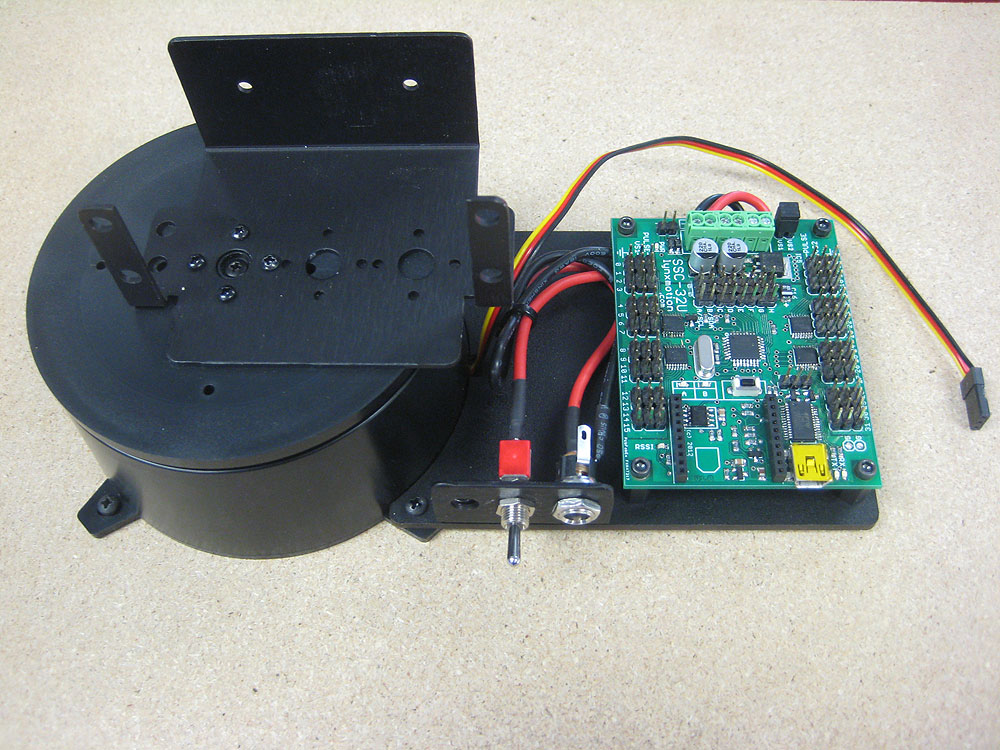 Figure 17b (SSC-32U) |
||||||||
| Step
18a (SSC-32). Plug the base rotate servo into the SSC-32 channel 0 as shown. Note that the black wire goes closest to the outside of the board and the yellow wire goes to inside (the "pulse"). |
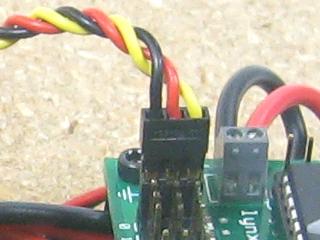 Figure 18a (SSC-32). |
||||||||
| Step
18b (SSC-32U). Plug the base rotate servo into the SSC-32U channel 0 as shown. Note that the black wire goes closest to the outside of the board and the yellow wire goes to inside (the "pulse"). |
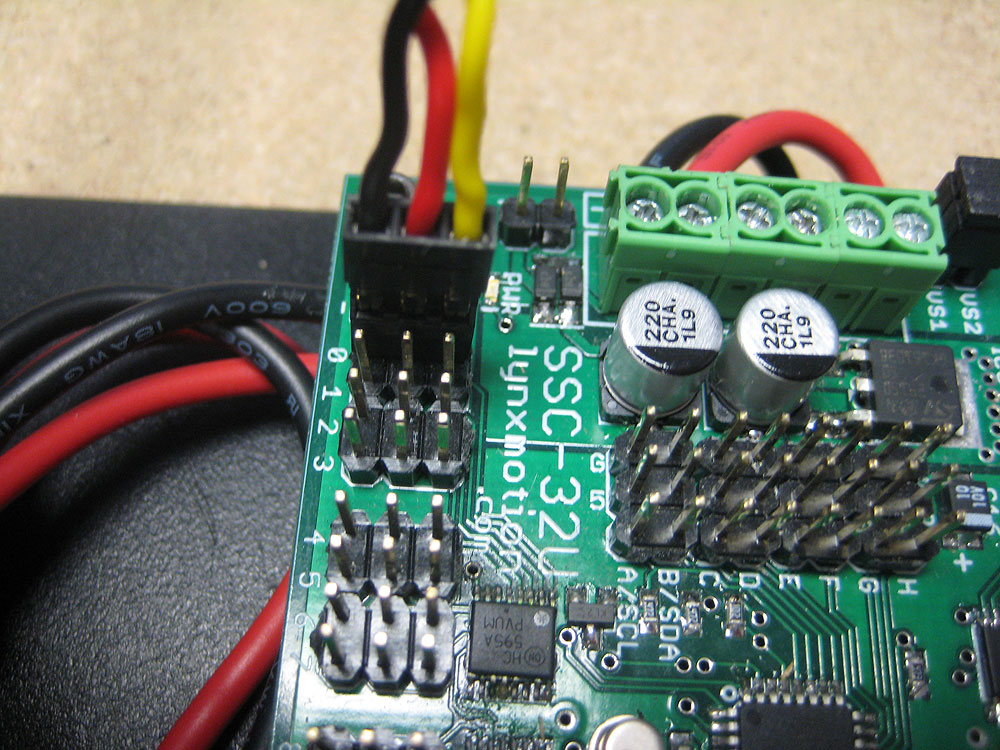 Figure 18b (SSC-32U). |
||||||||
| Step 19a (SSC-32). Plug in the wall pack and DB9 data cable as shown. The wall adapter provided is universal (110V-220V), so if it does not have the right plug for your country, you need only purchase an inexpensive plug adapter. To test communication, we'll use LynxTerm. Download and install LynxTerm. Connect the SSC-32 to the serial port and apply power. The green LED should light and stay on until it receives a valid serial command. Run the LynxTerm program. |
|
||||||||
| Step 19b (SSC-32). Plug in the wall pack and DB9 data cable as shown. The wall adapter provided is universal (110V-220V), so if it does not have the right plug for your country, you need only purchase an inexpensive plug adapter. |
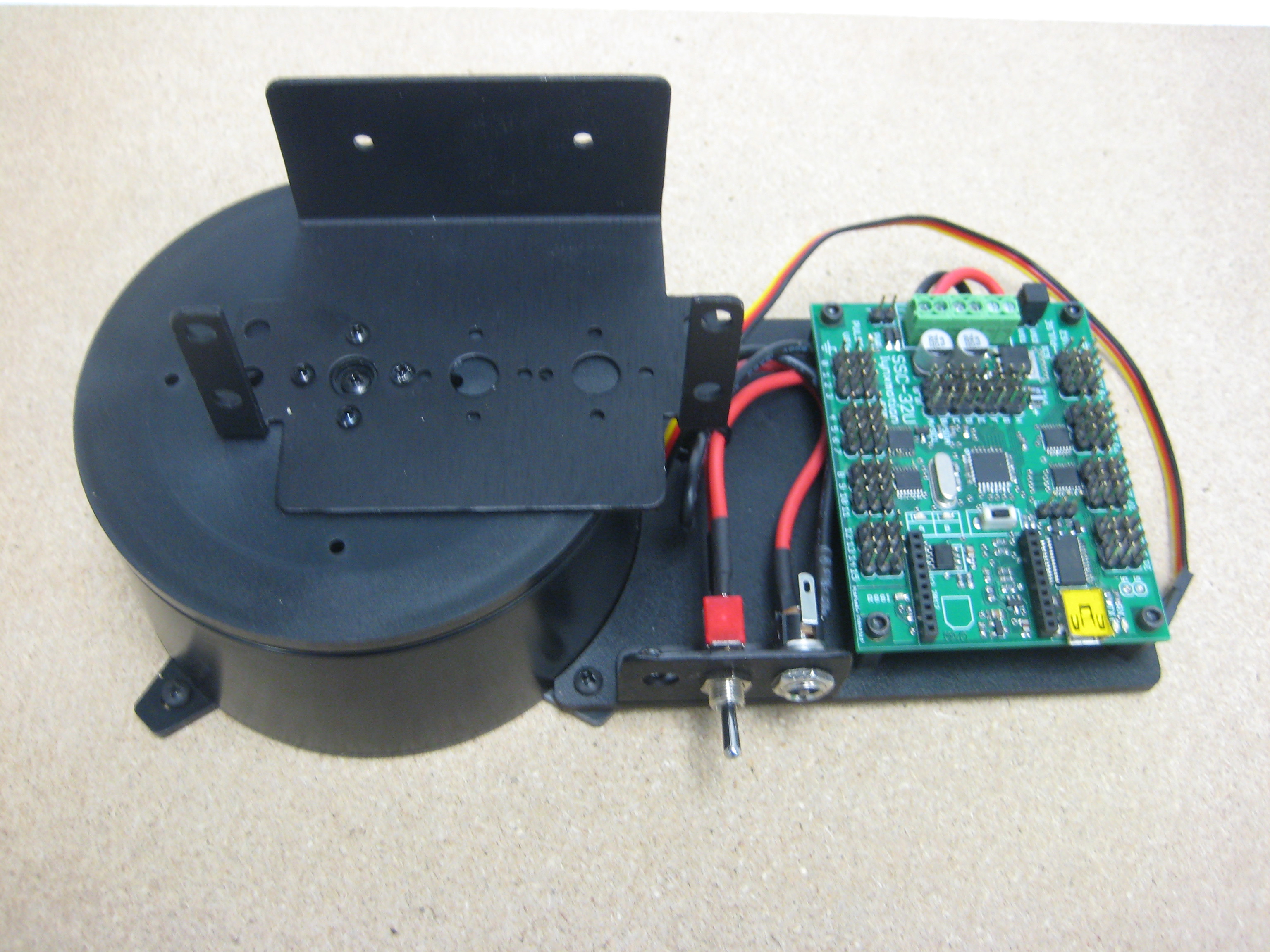 Figure 19b (SSC-32U) |
||||||||
| Step
20a (SSC-32U). The SSC-32 Servo Sequencer Utility is a free program which can be used with either the SSC-32 or SSC-32U. Download and install it on your computer. Ensure the On/Off switch is on (switch pointing between the two connected wires), and the board is powered and connected to the computer via USB. Run the program. The SSC-32U is shipped with a baud rate of 9600. Ensure the baud rate towards the bottom right of the window is set to 9600 (not 115200). The software should automatically detect which COM port is connected to the SSC-32U, and have installed the FTDI (USB to serial) drivers automatically. Using the slider at the top left of the screen (associated with servo 0) should cause the servo in the base to move physically. Turn the power off (on/off switch), remove both the power cable and the USB cable and continue with the next guide. |
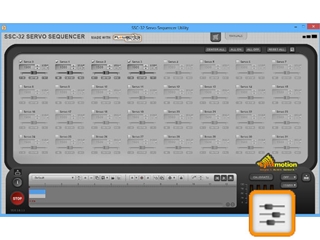 Figure 20a (SSC-32 Servo Sequencer Utility). |
||||||||
| Step
20b (SSC-32). Type "ver" and press "enter". You should see "SSC32-V2.01XE" or higher returned. If this process does not work, please consult the serial and USB-to-serial troubleshooting guide. Now it's time to test the servo. With Lynxterm installed, you can select channel 0 and move the slider to rotate the base, fun, huh? Before moving on, press the "All=1500" button to re-center the base servo.Turn the power off (on/off switch), remove both the power cable and the USB cable and continue with the next guide. |
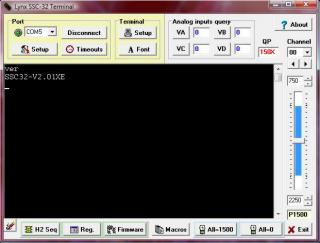 Figure 20 (Lynterm) |
||||||||










